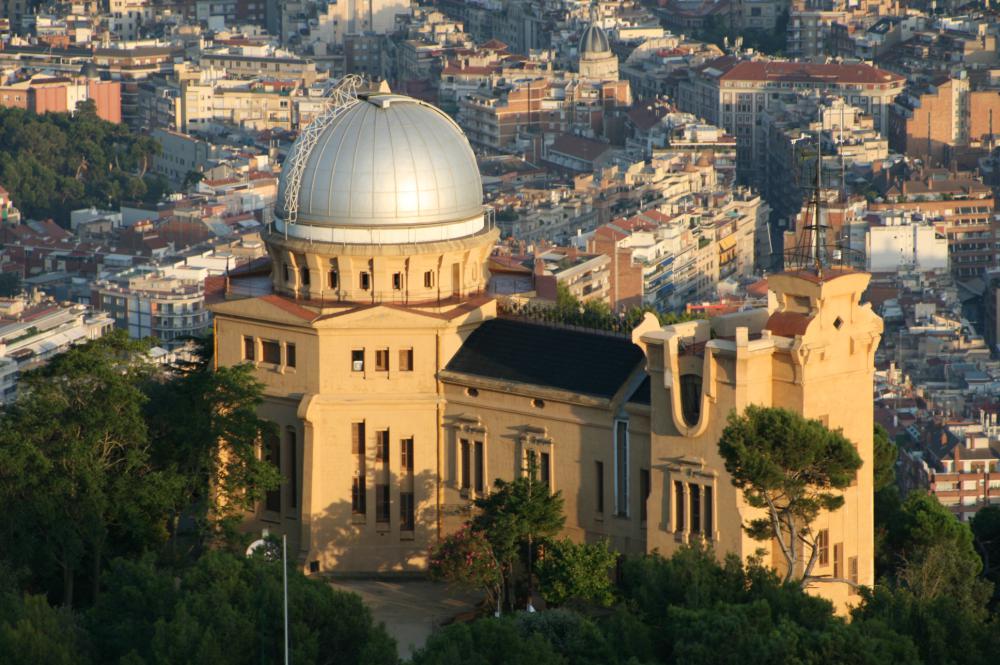
Category of Astronomical Heritage: tangible immovable
Fabra Observatory, Barcelona, Spain

Description
Geographical position
Observatori Fabra, Camí de l’Observatori, s/n, 08035 Barcelona
Location
Latitude 41°25’06’’N, Longitude 2°07’27’’E, Elevation 415m above mean sea level.
IAU observatory code
006
Description of (scientific/cultural/natural) heritage
The initiative for the creation of the Fabra Observatory arose from the RACAB, which in 1895 presented to the Provincial Council of Barcelona the project to build an observatory at the top of Tibidabo. This first project already contemplated the dual character, astronomical and meteorological, that was intended for the building. This first project, elaborated by doctors Josep Domènech i Estap├á and Eduard Fontserè, never came to fruition because the necessary capital was not reached and also, and mainly, because it interfered with other purposes with the same location


Fig. 1a,b. Fabra Observatory (Wikipedia 4, H. Raab, Wikipedia 3, Mister No)
Seven years later, the construction of the Observatory building in its final location began thanks to the legacy of Camil Fabra i Fontanills (1833--1902), first Marquis of Alella, who in 1901, according to a testamentary clause, left the amount of 250,000 pesetas at the disposal of the RACAB.
The Fabra Observatory, named after Camil Fabra i Fontanills, was established in 1904 and inaugurated on April 7, 1904 in the presence of King Alfonso XIII. It was designed by the modernist architect Josep Domènech i Estap├á (1858--1917) in Art Nouveau style. It is an octagonal building is under the dome. The first director was Josep Comas i Sol├á (1868--1937).
It belongs to the Royal Academy of Science and Arts of Barcelona (Catalan: Reial Acadèmia de Ciències i Arts de Barcelona).
Since its inception, the Observatory has worked in three areas: Astronomy, Meteorology and Seismology. The Meteorological Section started in 2013 and studies the local climatology in detail. The Seismic Section (since 1907) is involved in global seismology, but is primarily concerned with regional seismicity. The earthquake of Rubí on February 18, 1909, must be considered as the beginning of the Catalan regional seismology. At the Fabra Observatory, around 300 earthquakes are recorded each year, the epicenter of which can be located in any area of the planet. The Seismic Section has also had sensors in the Montseny massif since 1986 in order to improve the level of background and power noise, and to increase its amplification.
The main activity of the Astronomical Section of Fabra Observatory is dedicated to the astrometry of small planets, asteroids and comets, in the framework of international programs. It is one of the oldest observatories in the world that is still functioning. In this observatory, the comet 32P/Comas Solà was discovered by Josep Comas Solà (1868--1937) in 1926.
History

Fig. 2a. Observatori Fabra (1920), Servei Meteorol├▓gic de Catalunya (Wikipedia)

Fig. 2b. Observatori Fabra (1920) (Wikipedia 3, Arnaugir)

Fig. 3. Observatori Fabra, Refractor Mailhat (Wikipedia 4, H. Raab)
Instruments
- The double refractor was built by Mailhat, Paris, in 1904. The visual instrument (the lower of the two tubes) has an aperture of 38cm and a focal length of 6m (f/15.8). The photographic instrument also has an aperture of 38 cm, but a shorter focal length of 4m (f/10.5).
- Refracting telescope
- Baker-Nunn camera Schmidt telescope
- Seismographic devices of Italian origin (Cancani, Vicentini and Agamenone)
State of preservation
Protected: Bé Cultural d’Interès Nacional (2014-),
Bienes de Interés Cultural Reference IPA-40478
Comparison with related/similar sites
This octagonal building is under the dome reminds of many 18th centruy observatories with octagonal shape, going back to the Tower of the Winds in Athens in Antiquity.
Only very few observatories exist in Art Nouveau style:
Fabra Observatory, Spain (1904), Ondřejov Observatory (1908), Czech Republic, Observatório Central da UFRGS (Instituto Astronômico e Meteorológico, IAM) in Porto Alegre, Rio Grande do Sul, Brazil (1908), the Pavillon Hirsch (1909/11) of Neuchâtel Observatory, Switzerland.
Threats or potential threats
no threats, but many tourists.
Present use
still in use as an astronomical observatory.
Astronomical relevance today
The main activity of the Astronomical Section of the Fabra Observatory is the photographic astrometry of small planets and comets. This work consists of the determination of its astronomical position with great precision by means of the photographic technique. It uses the double refracting telescope, which due to its characteristics is the largest in Spain. For the measurement of the coordinates of the images impressed on the photographic plates he uses a high-precision optical-electronic single-comparator, connected directly to the computer equipment that finally provides the very precise astronomical position of the observed star (asteroid or comet).
References
Bibliography (books and published articles)
- Kronk, Gary W.: 32P/Comas Solá. In: Gary W. Kronk’s Cometography (http://cometography.com/pcomets/032p.html).
Links to external sites
- Observatori Fabra, Reial Acadèmia de Ciències i Arts de Barcelona, Homepage
http://www.fabra.cat/en_index.html - Josep Comas i Solà,
https://en.wikipedia.org/wiki/Josep_Comas_i_Solà
Links to external on-line pictures
no information available
No multimedia content published
Currently there is no multimedia content published for this case study













